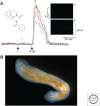Ca2+ Signaling and Regeneration
- PMID: 31308144
- PMCID: PMC6824241
- DOI: 10.1101/cshperspect.a035485
Ca2+ Signaling and Regeneration
Abstract
Regeneration is the process by which lost or damaged tissue is replaced in adult organisms. Some organisms exhibit robust regenerative capabilities, while others, including humans, do not. Understanding the molecular principles governing the regenerative malleability of different organisms is of fundamental biological interest. Further, this problem has clear impact for the field of "regenerative medicine," which aspires to understand how human cells, tissues, and organs may be restored to normal function in scenarios of disease, damage, or age-related decline. This review will focus on the planarian flatworm as a powerful model system for studying the role of Ca2+ signals in regeneration. These invertebrate animals display an astounding innate regenerative capacity capable of regenerating complete organisms from tiny, excised fragments. New knowledge and methodological capabilities in this system highlight the potential for studying the role of Ca2+ signaling at multiple stages of the regenerative blueprint that controls stem cell behavior in vivo.
Copyright © 2019 Cold Spring Harbor Laboratory Press; all rights reserved.
Figures



References
-
- Accorsi A, Williams MM, Ross EJ, Robb SMC, Elliott SA, Tu KC, Alvarado AS. 2017. Hands-on classroom activities for exploring regeneration and stem cell biology with planarians. Am Biol Teach 79: 208–223. 10.1525/abt.2017.79.3.208 - DOI
-
- An Y, Kawaguchi A, Zhao C, Toyoda A, Sharifi-Zarchi A, Mousavi SA, Bagherzadeh R, Inoue T, Ogino H, Fujiyama A, et al. 2018. Draft genome of Dugesia japonica provides insights into conserved regulatory elements of the brain restriction gene nou-darake in planarians. Zoological Lett 4: 24 10.1186/s40851-018-0102-2 - DOI - PMC - PubMed
Publication types
MeSH terms
Grants and funding
LinkOut - more resources
Full Text Sources
Miscellaneous
